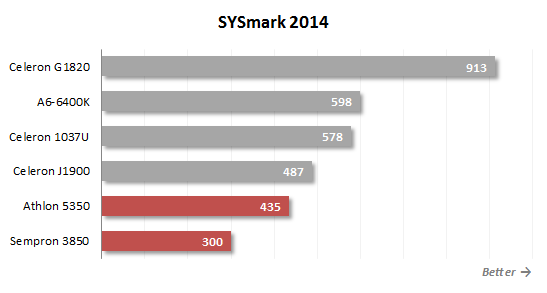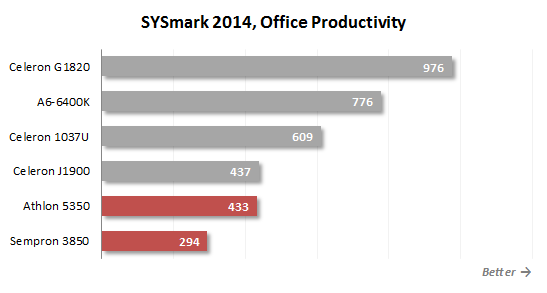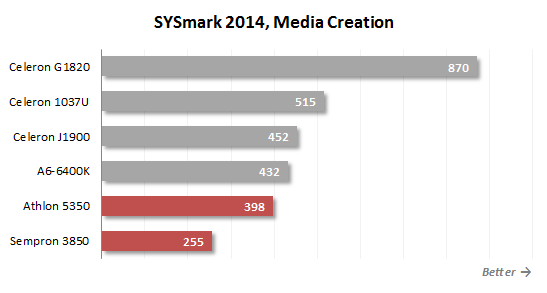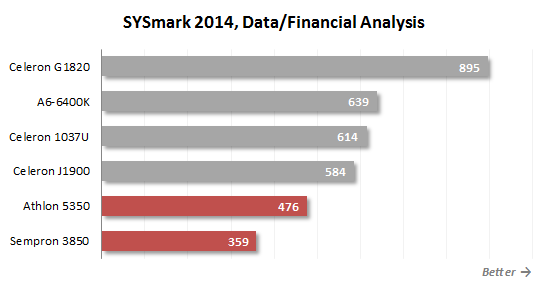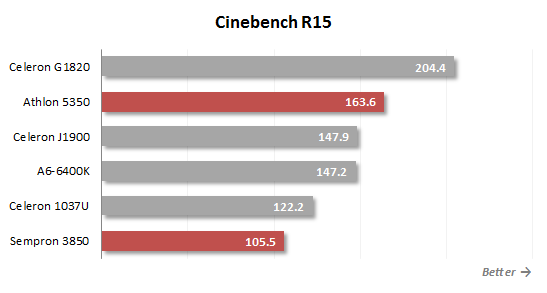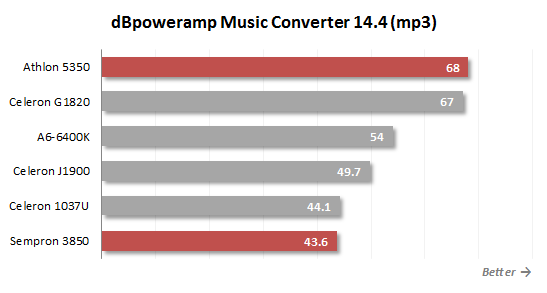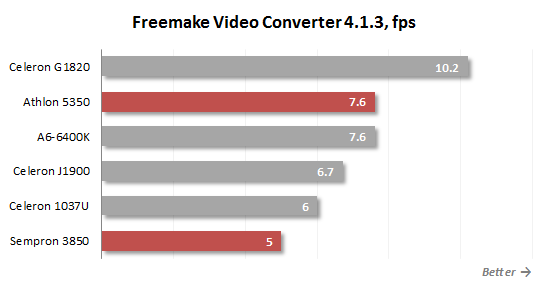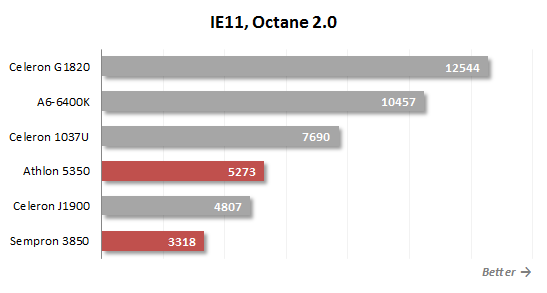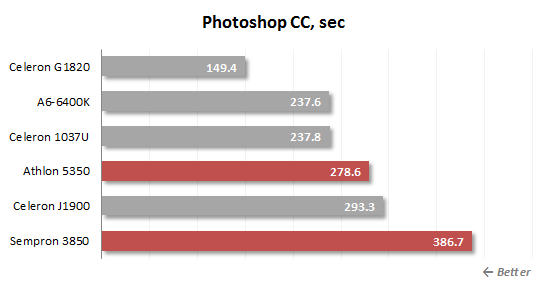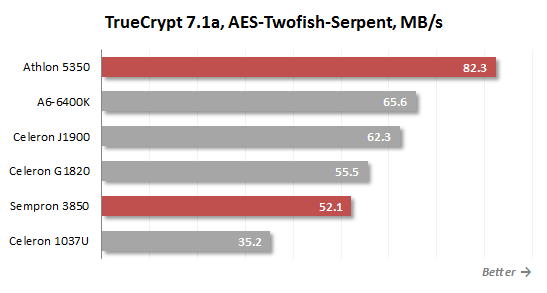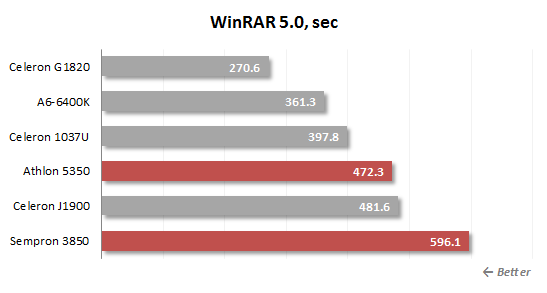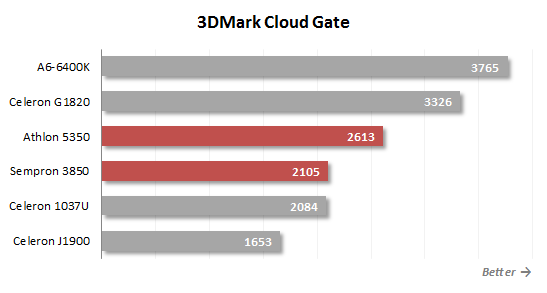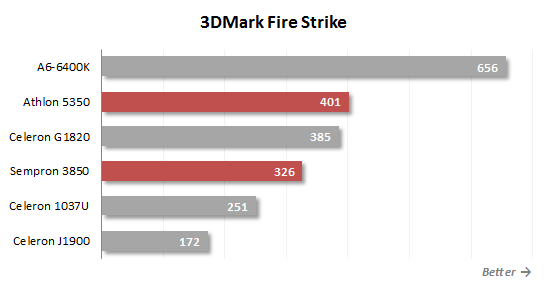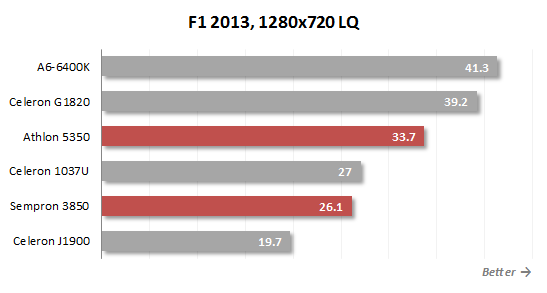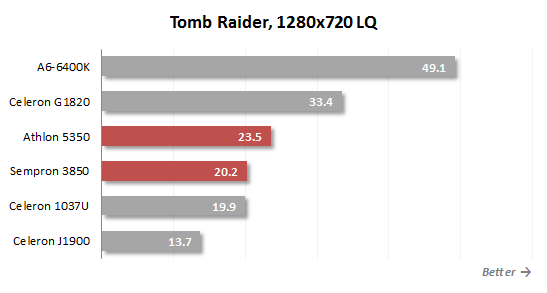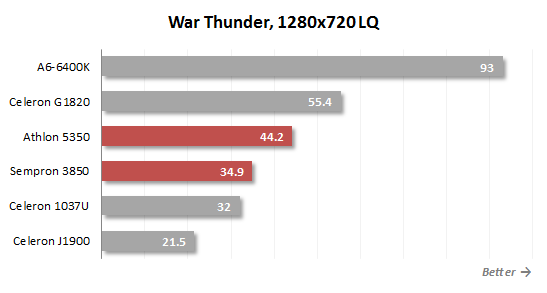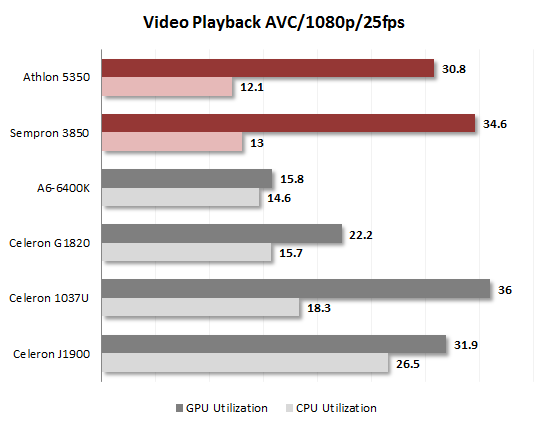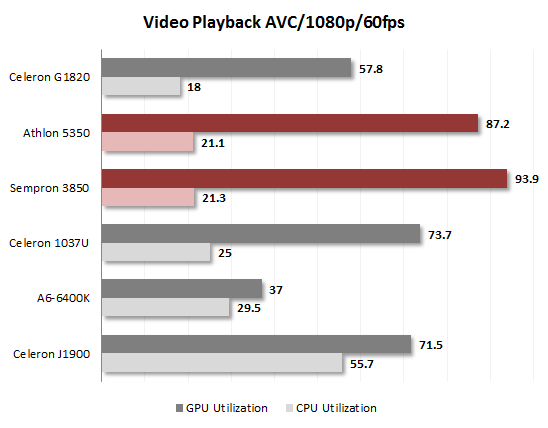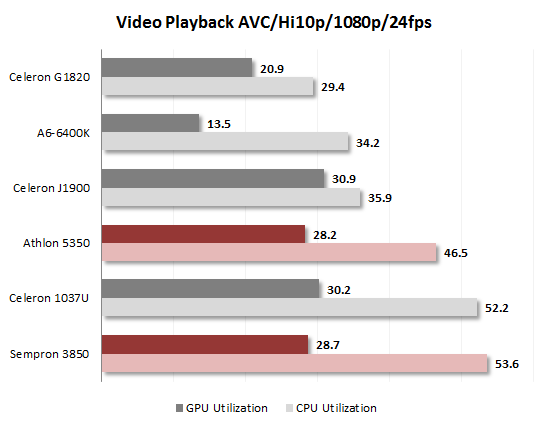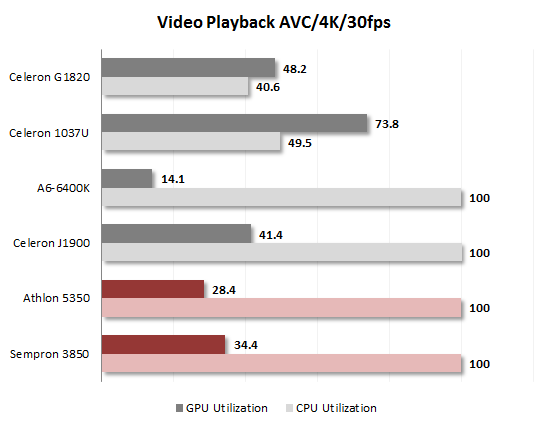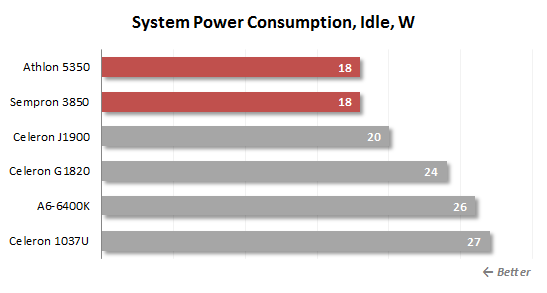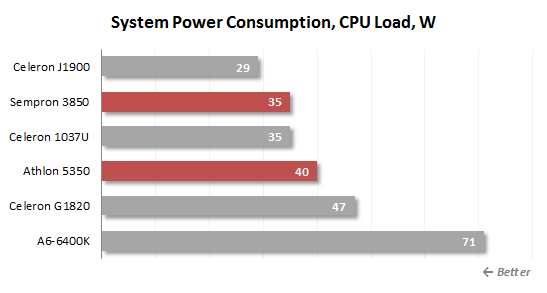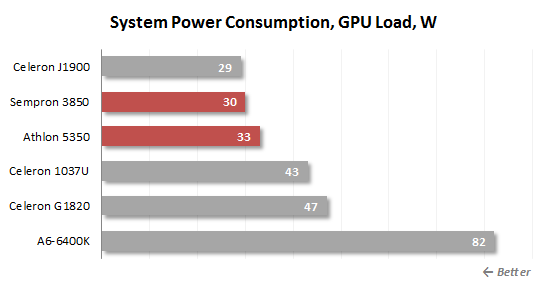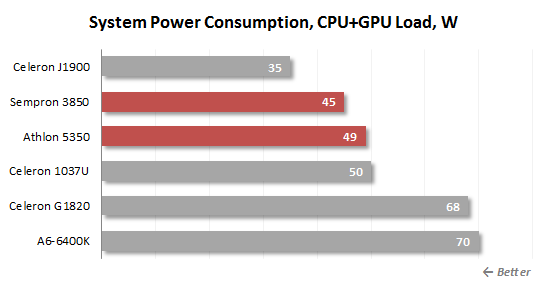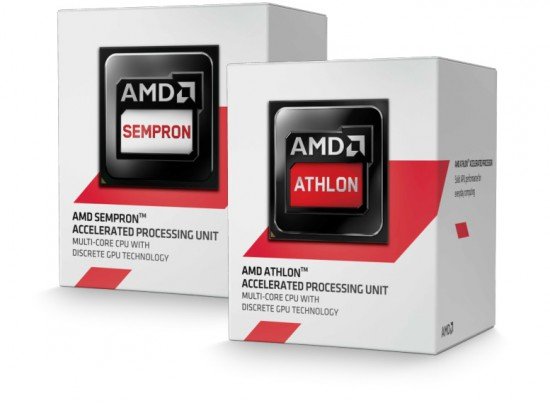Athlon 5350 and Sempron 3850 Processors (Kabini) and Socket AM1 Platform Review

AMD’s latest financial reports prove that the company has been shipping less desktop processors with each passing quarter. There’s nothing particularly unexpected about this trend. AMD’s processor architectures have been developing in such a way as to make AMD’s products less interesting for desktop users.
We don’t have to look far for examples. AMD’s flagship FX series has long ceased to develop, so it is now inferior to Intel’s offers and has downright outdated specs. Midrange hybrid processors from AMD are oriented at mobile solutions. Their desktop versions, although updated regularly, are niche products for a limited scope of applications. The recently released Kaveri-based desktop APUs even turn out to be slower than their predecessors, which doesn’t help them get any more attractive in the end-user’s eyes. Quite expectedly, even loyal AMD fans start to rethink their allegiance, especially as the manufacturer doesn’t give them any hope for any changes in the situation.
There are no high-performance processors on AMD’s plans whereas the company’s upcoming APUs will likely be optimized in terms of power consumption rather than speed. That said, AMD still has some technologies that can be potentially used for desktop processors. Besides the family of Bulldozer-related designs, which is currently represented by the Steamroller microarchitecture, AMD has the Bobcat design, later developed into what is codenamed Jaguar.
While the Bulldozer was being perfected in terms of energy efficiency (and becoming slower in the process), the Bobcat/Jaguar microarchitecture was energy-efficient to start with, so it could be perfected in terms of speed. AMD has achieved some success on this road. Originally targeted at inexpensive and low-performance gadgets like netbooks and nettops, the Jaguar design eventually made it into gaming consoles, which are a higher class of products. Thanks to that, AMD has got a long-term contract and improved its reputation as a maker of competitive processors. Building on this success, the company now wants the Jaguar to become recognized on the market of desktop PCs as well.
Based on the Jaguar microarchitecture, Kabini series processors have long been used in mobile computers, actually. AMD thinks they may also be optimal for compact desktop computers if their functionality is up to the mark. To make full-featured desktop processors out of them, AMD has developed a new ecosystem, known as Socket AM1, and prepared a whole new model range.
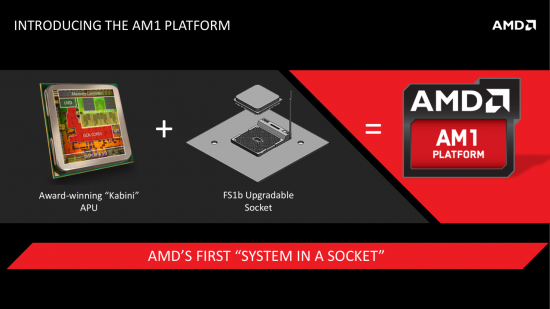
AMD claims that the Socket AM1 platform is so affordable that it can become a real bestseller in the entry-level market segment. Affordable computers are said to be hugely popular on the developing markets, so AMD thinks that the desktop Jaguar-based processors are going to be a hit in Latin America.
As a matter of fact, the Kabini is not something really new. Such processors have been available for over a year and there were no obstacles to introducing them into desktop PCs. Few people wanted to do so, though. Mainboard makers had to develop their own product designs to support the Kabini whereas the demand for such solutions was uncertain. But things are different now. Thanks to the gaming consoles, Jaguar-based processors have become more interesting for end-users whereas AMD has voiced its intention to collaborate with mainboard manufacturers and promote the Socket AM1 platform. It means that Socket AM1 mainboards and processors will become widely available in the near future – and at most attractive prices. It is for buyers who are going to be lured by that low pricing that we want to test the new Kabini and check out their practical worth in this review.
Desktop Kabini Series: Architecture Details
The Kabini announcement changes the entry-level market segment. Until now, processors of this kind, including Intel’s Atom or AMD’s Zacate, were soldered to the mainboard whereas the Kabini is installed into a socket. AMD thinks that the opportunity to upgrade the processor may be an important advantage. It may attract users who used to prefer inexpensive tablets, netbooks, nettops, Chromebooks and other surrogates of full-featured PCs.
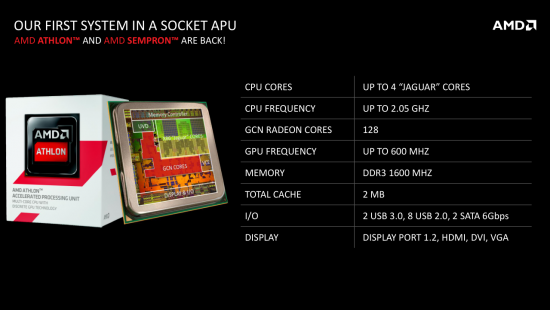
Four processor models are offered at the launch of the Socket AM1 platform:
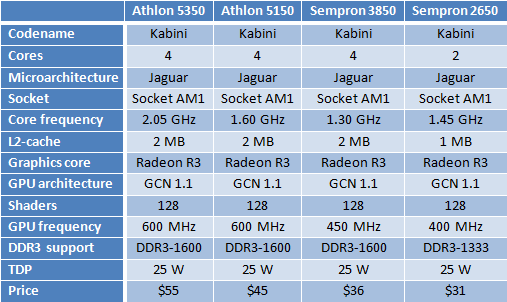
Each model is based on a 28nm semiconductor die and incorporates four or two computing cores with Jaguar architecture and a GCN graphics core with 128 shader processors. Thus, the Socket AM1 compatible Kabini products are very similar in their specs to the mobile processors which have been available for near a year. The Athlon 5350 is similar to the A6-5200 and the Athlon 5150, to the A4-5100. The Sempron 3850 and 2650 models are closely related to the E2-3800 and E1-2500. There is a small difference in terms of the graphics core frequency and TDP but overall the new desktop Kabini series is very much alike to the old mobile one. And that’s not good news. AMD just has been unable to improve the frequency potential of its junior processor series over the last year.
People who hope to use the Socket AM1 platform to build something like a latest gaming console from Sony or Microsoft will be disappointed, too. The console processors have 8 Jaguar cores clocked at about 2 GHz and their GCN graphics core has 768 or more shader processors. In other words, the new desktop Kabini models are inferior to the console APUs.
AMD obviously targets the entry-level market segment, promoting the Socket AM1 platform as a further development of the Brazos 2.0. Compared to the Zacate APUs, the Kabini series are more advanced just because they have twice the number of computing cores.
The Jaguar architecture itself brings about certain improvements over its predecessor Bobcat. They are not critical, though, just like in the Bulldozer branch of AMD’s processor designs. Developed with energy efficiency in mind, the Jaguar can execute two instructions per clock cycles, equaling Intel’s Silvermont architecture implemented in Bay Trail series processors. The Jaguar uses out-of-order execution, just like its predecessor. The key changes in this microarchitecture are only meant to increase efficiency of the resources available since the Bobcat, so they can mostly be seen in the input part of the execution pipeline.
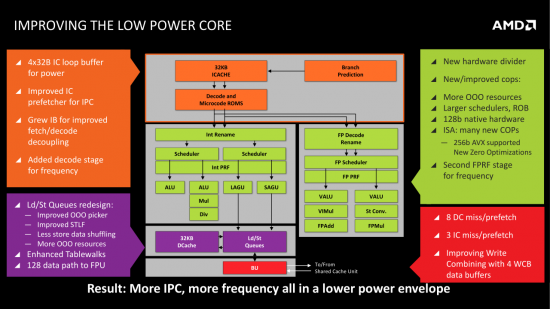
First, the L1 instruction cache is complemented with an additional 128-byte loop buffer. It helps avoid repeatedly fetching the same instructions from the L1 cache while executing a loop. It doesn’t improve performance as its latency isn’t any better. It only helps reduce power consumption. Second, the Jaguar features an improved instruction prefetch algorithm. Third, the new microarchitecture has a larger buffer between the L1 cache and the instruction decode unit. And fourth, the execution pipeline is longer by one decode stage to improve frequency potential because the clock rate of the Bobcat design was limited by the decode unit.
There are some changes in terms of instruction execution. The Jaguar features an updated instruction set including SSE4.1/4.2, AES, CLMUL, MOVBE, AVX, F16C and BMI1. The floating-point unit had to be redesigned for that. The Bobcat had a 64-bit FPU whereas the Jaguar has a 128-bit one. As a result, 256-bit AVX instructions are executed in two steps while 128-bit instructions don’t have to be split up anymore. The floating-point pipeline is longer by 1 stage in the Jaguar, yet the new microarchitecture claims to be much faster than its predecessor when it comes to vector operations.
There are changes about integer instructions, too. Although the Bobcat was quite fast with ordinary code, the Jaguar introduces a new integer division unit borrowed from the K10.5 microarchitecture. The division speed is doubled as the result.
AMD has also made the scheduler’s buffers larger to improve the efficiency of out-of-order instruction execution.
The load-store unit works in the energy-efficient Bobcat and Jaguar designs in the same way as in the regular processors. We mean that it can prefetch and reorder data requests. The prefetch algorithm was improved in AMD’s latest Piledriver and Steamroller designs and now it is implemented in the Jaguar. The result is 15-percent acceleration in terms of data loading and storing.
All of the improvements in the microarchitecture make one Jaguar core about 17% more efficient in comparison with a Bobcat core. Coupled with the potentially higher clock rates and the increased number of cores, AMD claims the Kabini series are going to be 2 or 4 times as fast as their Zacate predecessors.
The new processors’ speed at multithreaded load is affected by the processing module structure. Each core used to have a dedicated L2 cache (clocked at half the processor’s clock rate) and different cores were connected via an external bus. The Jaguar uses a shared L2 cache instead. One quad-core Kabini module includes a shared 16-way associative L2 cache with a capacity up to 2 megabytes. For the first time in AMD processors, the cache is inclusive, meaning that it duplicates data stored in the L1 cache. This requires more cache memory but has a positive effect on multithreaded performance.
Thanks to the more advanced 28nm tech process and certain manufacturing techniques from the GPU field, one Jaguar core fits into an area of 3.1 sq. mm whereas a 40nm Bobcat core used to take up 4.9 sq. mm. So the addition of a large L2 cache doesn’t make the die larger and costlier to make.
Like AMD’s more advanced APUs, the Kabini features an integrated graphics core with the latest GCN architecture, the same as is used in AMD’s flagship graphics cards. That’s why the Kabini supports all modern APIs: DirectX 11.1, OpenGL 4.3 and OpenCL 1.2. The Kabini is inferior in terms of its GPU resources, though. It has only two execution clusters for a total of 128 shader processors, which is fewer than in the junior graphics cards of the Radeon R5 series. The Kabini’s graphics core is referred to as Radeon R3. Besides the 128 shader processors, the integrated core contains eight texture-mapping units and four raster operators. It also includes a command processor and four independent asynchronous compute engines for heterogeneous computing. The Kabini doesn’t support HSA technologies, though.
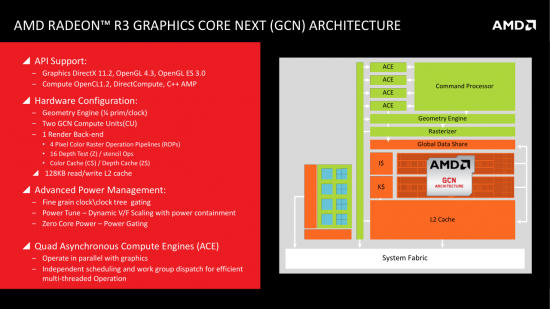
Despite its inferior specs, the Kabini’s integrated graphics core incorporates full-featured VCE and UVD engines, which means hardware acceleration for decoding video in H.264, VC-1, MPEG-2, MVC, DivX and WMV formats and for encoding H.264 video at Full-HD resolution. The latter function isn’t used in popular transcoding tools for some reason, though.
Unfortunately, for all the improvements in the architecture of its x86 and graphics cores, the Kabini still has a single-channel memory controller. It supports up to DDR3-1600 SDRAM, so the Socket AM1 platform may be limited by memory bandwidth in many applications. The graphics core is going to be impeded by this factor, too.
The good news is that the new desktop Kabini, just like its mobile counterpart, is a system-on-chip. So besides the x86 and graphics cores, memory controller and North Bridge, it incorporates a South Bridge with SATA 6 Gbit/s, USB 3.0 and PCI Express 2.0 controllers, allowing to connect peripheral devices.
Launching its Kabini processors, AMD dusts off its Athlon and Sempron trademarks, which may be a cause for some confusion because AMD also ships the Richland-based Athlon X4 for Socket FM2 and the Sempron 145 for Socket AM3.
The new Athlon and Sempron processors for low-end desktop PCs are affordable indeed. The senior Kabini costs a mere $55 and, as mentioned above, comes with a full selection of integrated peripheral controllers. It means that mainboards for such processors don’t have to carry those controllers and may be as cheap as $35. In this case, the cheapest Socket AM1 configuration is going to cost you a mere $65-70. You only have to add something like system memory, a storage device and a computer case.
There’s nothing extraordinary about the pricing. Incorporating 914 million transistors, the Kabini semiconductor die is extremely small. Its size is only 105 sq. mm.
AMD offers the following illustration: four Jaguar cores take up about the same area as one dual-core Steamroller module.
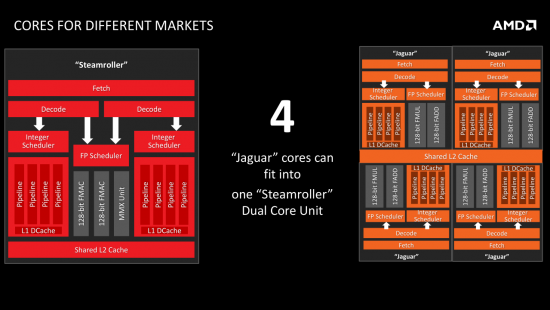
Indeed, the latest Kaveri’s die is 245 sq. mm large. We can also put forth another example: the dual-core Haswell with GT1 graphics, manufactured on the more advanced 22nm tech process, is 107 sq. mm large.
Socket AM1 Platform
The new Socket AM1 platform launched especially for AMD’s affordable energy-efficient processors features a new socket which is not compatible with anything other than the new Kabini series. It had been codenamed Socket FS1b in technical documentation.
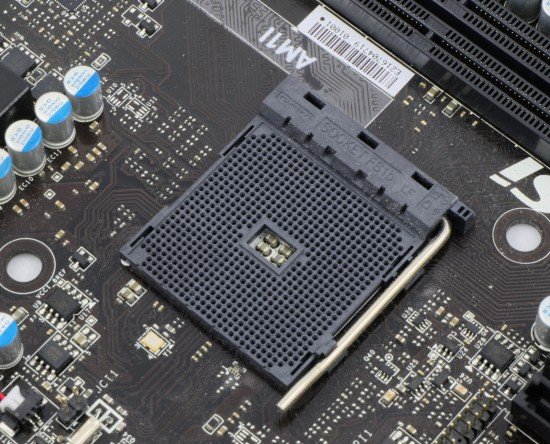
The processor socket resembles AMD’s “full-size” ones in design but has fewer contacts (721) and takes less room on the mainboard.
To test the new platform we will use MSI’s mini-ITX AM1I mainboard. Its design is going to be typical of all mainboards for the desktop Kabini series.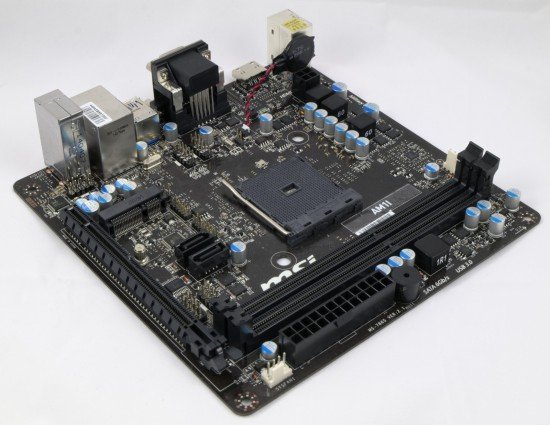
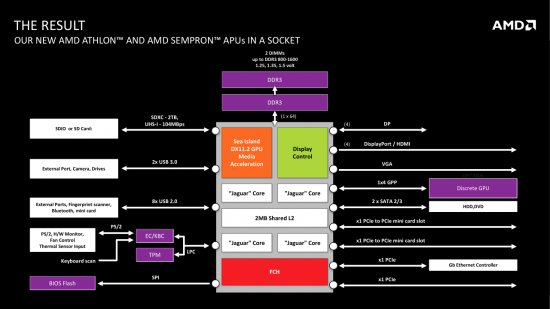
The Kabini’s integrated controllers support the following:
- Eight PCI Express 2.0 lanes which can be wired to a PCI Express slot or external controllers, e.g. a wired or Wi-Fi network controller
- Two USB 3.0 ports and eight USB 2.0 ports
- Up to four digital display outputs with 4K resolution (DVI, HDMI, DisplayPort) and an analog display output
- Two SATA 6 Gbit/s channels without RAID functionality
- SDXC UHS-I interface with up to 104 MB/s bandwidth for SD memory cards
Building on this foundation, MSI offers a mainboard with two DDR3 SDRAM slots (in single-channel mode), one PCI Express x16 slot (in x4 mode), and a mini-PCI slot (for a half-size card). The mainboard also carries two SATA 6 Gbit/s ports and two headers for four additional USB 2.0 ports. You can connect serial and parallel ports as well as a TPM module. There are two fan connectors (the CPU one only supports 3-pin connection).
On the mainboard’s back panel, there are two PS/2 ports for mouse and keyboard, video outputs (D-Sub, DVI-D, and HDMI), two USB 2.0 ports, two USB 3.0 ports, an RJ-45 connector (Gigabit Ethernet) and three analog audio connectors. The LAN interface is based on a Realtek RTL8111G controller whereas the analog audio is based on an 8-channel codec Realtek ALC887. It must be noted that the mainboard can output to two displays concurrently in clone or desktop extension modes. Resolutions above 1920×1200 pixels are only supported via HDMI connection.
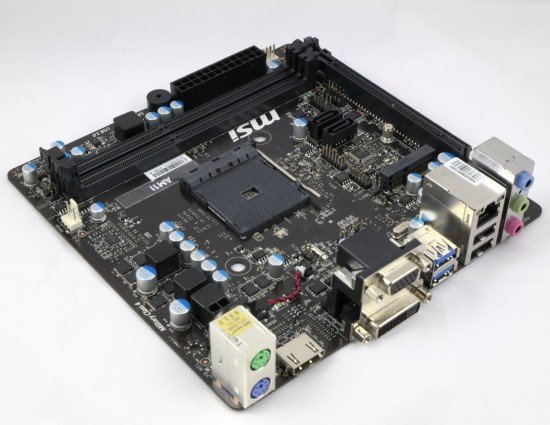
The MSI AM1I has a 3-channel voltage regulator, which should be quite enough for processors with a peak power draw of 25 watts, especially as the Socket AM1 platform doesn’t provide any overclocking capabilities. The top memory frequency you can choose in the mainboard’s BIOS is 1600 MHz. The processor’s frequency multiplier cannot be increased and there are no options altogether to change the base clock rate.
Besides MSI, nearly every other brand has announced its own mini-ITX and micro-ATX mainboards for Socket AM1 processors although they had not been so eager to do so in the past. The Taiwanese firms seem to see some perspectives in the Socket AM1 platform.
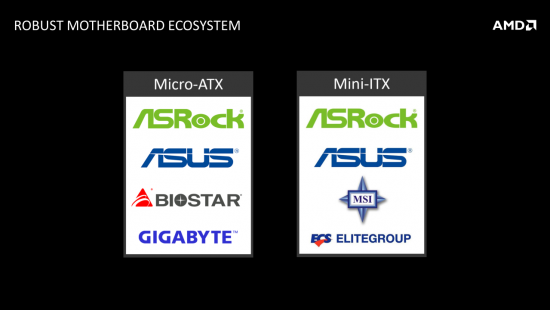
The new platform brings about a new CPU cooler format with a revised fastening mechanism. Coolers for AMD processors used to be fastened to the processor’s frame whereas the Kabini cooler is secured with two plastic dowels which are inserted into openings located at two opposite corners of the processor socket. The openings are only 85 mm apart from each other.
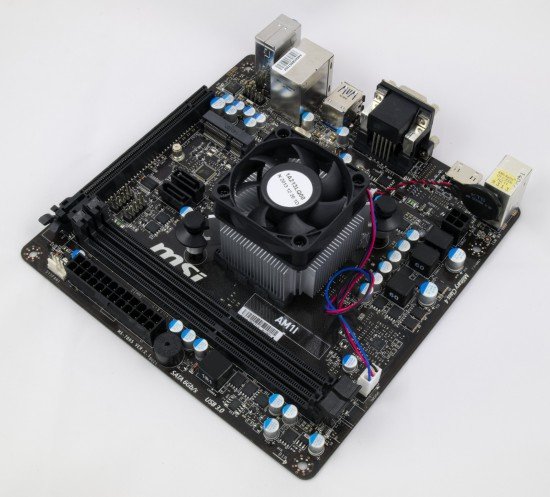
The default cooler is a rather small aluminum heatsink with a buzzing 50mm fan that has a peak speed of 3000 RPM and is controlled via voltage adjustment. Passive cooling would be far more appropriate, yet a passive heatsink capable of dissipating up to 25 watts wouldn’t be cheap, so it wouldn’t fit well with the Socket AM1 concept. Anyway, a number of cooler makers promise to support the new format, so there will probably appear alternatives coolers in the near future.
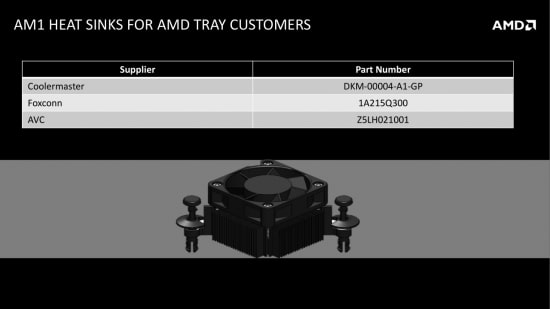
Designing the Kabini as a processor that can be inserted into a socket only makes sense in terms of upgrade opportunities. However, the future perspectives of the Socket AM1 platform look rather vague as yet. On one hand, AMD is supposed to transition from the Kabini to the Beema design but has not yet made any statement as to their pin compatibility. It is possible that the desktop Beema will have a DDR4 controller, making the Socket AM1 platform a dead end with no upgrade options. Moreover, considering that the Kabini incorporates a South Bridge, AMD shouldn’t add or change any interfaces in its future Socket AM1 processors for the sake of compatibility. In other words, if the manufacturer wants to add more PCIe lanes, switch to a newer PCIe version, implement M.2 support or something like that, a new version of the CPU socket will probably be required.
Tested Processors: Athlon 5350 and Sempron 3850
We’ve got two processors to test the Socket AM1 platform with: Athlon 5350 and Sempron 3850.
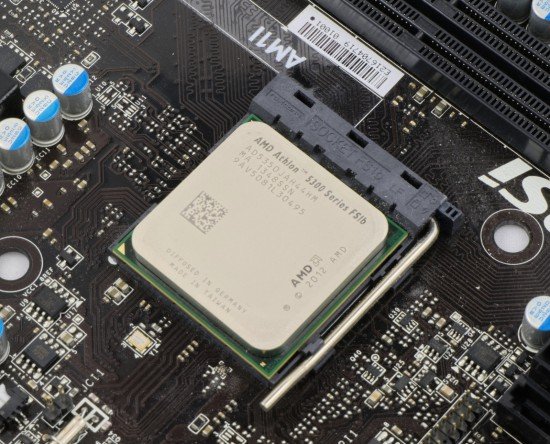

They are actually very similar to each other. Each of these systems-on-chip contains four x86 cores with Jaguar microarchitecture and their GCN graphics core contains 128 shader processors. Each has a shared 2MB L2 cache. The only difference between them is their clock rate. The Athlon 5350 is clocked at 2050 MHz whereas the Sempron 3850, at a far lower 1300 MHz.
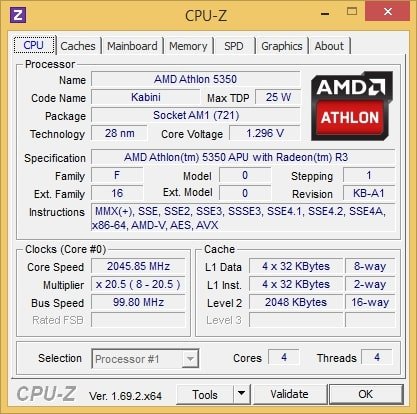
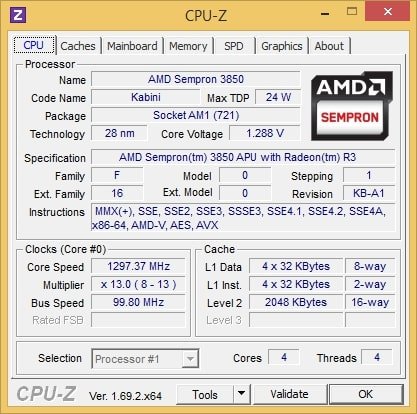
The integrated graphics cores have different clock rates, too. The senior Athlon model clocks its graphics at 600 MHz while the Sempron 3850 clocks it at 450 MHz.
Both processors work at a voltage of 1.3 volts. In idle mode their clock rate is dropped to 800 MHz and their voltage, to 1.0375 volts. The graphics core is clocked at 266 MHz in idle mode. There is no Turbo mode for the Kabini’s x86 or graphics cores.
Testbed and Methods
Announcing the Socket AM1 platform and Kabini processors, AMD positioned them as an alternative to Intel’s desktop Bay Trail-D products, namely Celeron J1800, Celeron J1900 and Pentium J2900.
The picture from AMD’s marketing department shows everything in a bright light. The Kabini series is obviously preferable in terms of price:
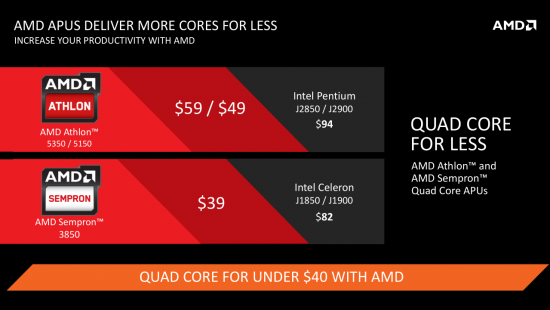
The reality is different from what we see in the picture, though. Desktop mini-ITX mainboards with Bay Trail-D processors are actually cheaper as Intel ships its systems-on-chip at a considerable discount. For example, a Celeron J1900 based platform from ASRock or Gigabyte can be bought for $80-90, which is comparable to the price of an Athlon 5350 plus a compatible mainboard. And the Intel solution will be far more economical. The typical heat dissipation of desktop Bay Trail-D processors is specified at 10 watts whereas the Kabini’s is 2.5 times higher.
There’re also more appropriate Intel-based opponents to the Socket AM1 platform. We mean desktop mainboards with integrated low-voltage Celeron processors with Ivy Bridge microarchitecture. Mini-ITX products with Celeron 1037U or similar solutions are available from Biostar, Gigabyte, Foxconn, Elitegroup and many other brands. They cost about the same money ($70-90) and the typical heat dissipation of such processors (together with the chipset, which is necessary in this case) is 21 watts.
So, we seem to have some wishful thinking on AMD’s part as the company pits the Socket AM1 platform against an opponent which is not actually an opponent. We won’t buy that, so in our testing the desktop Kabini processors will be competing not only with the Bay Trail-D Celeron but also with the energy-efficient Celeron with Ivy Bridge microarchitecture.
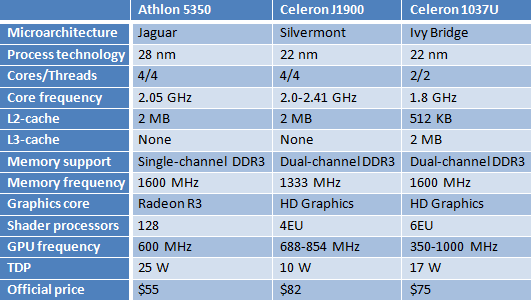
Besides the Celeron J1900 and Celeron 1037U, the Athlon 5350 and Sempron 3850 will be compared with two regular desktop processors from the entry-level segment: Celeron G1820 and A6-6400K. They cannot serve as an alternative to the Kabini series, yet will help us realize in which aspects the energy-efficient Socket AM1 platform is better or worse than the Socket FM2 and LGA1150 platforms that can be represented by compact mini-ITX mainboards, too.
Below is the full list of hardware components we will use in this test session.
- Processors:
- AMD A6-6400K (Richland, 2 cores, 3.9-4.1 GHz, 1MB L2 cache, Radeon R5)
- AMD Athlon 5350 (Kabini, 4 cores, 2.05 GHz, 2MB L2 cache, Radeon R3)
- AMD Sempron 3850 (Kabini, 4 cores, 1.3 GHz, 2MB L2 cache, Radeon R3)
- Intel Celeron G1820 (Haswell, 2 cores, 2.7 GHz, 2x256KB L2 cache, 2MB L3 cache, HD Graphics)
- Intel Celeron 1037U (Ivy Bridge, 2 cores, 1.8 GHz, 2x256KB L2 cache, 2MB L3 cache, HD Graphics)
- Intel Celeron J1900 (Bay Trail-D, 4 cores, 2.0-2.41 GHz, 2MB L2 cache, HD Graphics)
- Mainboards:
- ASRock FM2A88X-ITX+ (Socket FM2+, AMD A88X)
- Gigabyte C1037UN-EU (Celeron 1037U, Intel NM70)
- Gigabyte J1900N-D3V (Celeron J1900 SoC)
- MSI AM1I (Socket AM1 SoC)
- MSI Z87I (LGA 1150, Intel Z87 Express)
- System memory:
- 2 x 4 GB, DDR3-1866 SDRAM DIMM, 9-11-9-27 (Kingston KHX1866C9D3K2/8GX)
- 2 x 4 GB, DDR3L-1600 SDRAM SO-DIMM, 11-11-11-29 (2 x Crucial CT51264BF160BJ.C8FER)
- Storage: Intel SSD 520 240GB (SSDSC2CW240A3K5)
- Power supply: Corsair AX760i (80 Plus Platinum, 760 W)
- Operating system: Microsoft Windows 8.1 Enterprise x64
- Drivers:
- AMD Chipset Drivers 14.4
- AMD Catalyst Display Driver 14.4
- Intel Chipset Driver 10.0.13.0
- Intel Graphics Driver 10.18.10.3498
Performance
General performance
As usual, we use the Bapco SYSmark suite to estimate performance in everyday computing tasks. It emulates a user working in popular office and digital content creation and processing applications. The test produces a single score indicative of the computer’s average performance across different applications. SYSmark has been updated recently, so we use the latest version, SYSmark 2014, for our tests.
The desktop Kabini processors, running on the Socket AM1 platform, perform exactly as expected. Their performance is much lower compared to Intel’s alternatives in everyday applications. It may be due to downsides of the Jaguar microarchitecture or a lack of software optimizations for AMD solutions, but it is a fact anyway. Even the fastest Socket AM1 processor, Athlon 5350, falls behind the midrange Bay Trail-D model, Celeron J1900, by about 10% and is also about 25% inferior to the energy-efficient dual-core Celeron 1037U. So, the release of inexpensive desktop Kabini processors can hardly change the market situation, especially as AMD’s quad-core products of this kind are much slower than Intel’s Haswell-based entry-level solutions.
Now let’s take a closer look at the performance scores SYSmark 2014 generates in different usage scenarios. The Office Productivity scenario emulates typical office tasks, such as text editing, spreadsheets, email and web-surfing. This scenario uses the following applications: Adobe Acrobat XI Pro, Google Chrome, Microsoft Excel 2013, Microsoft OneNote 2013, Microsoft Outlook 2013, Microsoft PowerPoint 2013, Microsoft Word 2013, and WinZip Pro 17.5.
The Media Creation scenario emulates the creation of a video clip out of prepared materials (digital images and videos) using Adobe Photoshop CS6 Extended, Adobe Premiere Pro CS6 и Trimble SketchUp Pro 2013.
The Data/Financial Analysis scenario is devoted to statistical and market analysis. It processes a lot of numerical data in two applications: Microsoft Excel 2013 and WinZip Pro 17.5.
As we can see, the Socket AM1 platform isn’t fast in any of the scenarios. Its performance is lower than that of Intel’s energy-efficient and affordable platforms. Interestingly, the quad-core Jaguar-based processors are inferior to any kind of dual-core processor: those with Ivy Bridge, Haswell or Piledriver design. The Jaguar’s performance-per-core seems to be very low and this cannot be made up for by simply increasing the number of cores per processor.
Application Tests
Maxon has recently updated its benchmark, so Cinebench R15 can estimate the speed of 3D rendering in the latest versions of the Cinema 4D animation suite.
The Kabini doesn’t look so bad in Cinebench. The senior desktop model of this series, Athlon 5350, is even ahead of its main opponents Celeron J1900 and Celeron 1037U. Well, the Jaguar microarchitecture is actually optimized for parallel integer algorithms like final rendering. The Sempron 3850 doesn’t follow suit, though. Its clock rate is too low to deliver acceptable performance.
Using dBpoweramp Music Converter R14.4, we benchmark the speed of converting FLAC files into MP3 format with maximum compression quality. The score is the ratio of conversion speed to playback speed.
The results are close to what we’ve seen in the previous test. The Lame codec, used in multithreaded version here, runs smoothly on the Kabini processors. The Athlon 5350 is even a little faster than the full-featured dual-core Haswell, Celeron G1820. The Jaguar’s good performance is due to the same reasons: it runs an algorithm without branching and with integer data.
We check out the speed of HD video transcoding with the popular free tool Freemake Video Converter 4.1.1. It uses the FFmpeg library and is based on the x264 coder, but features certain optimizations. We enable DXVA technology for hardware acceleration.
Video transcoding is a more sophisticated task, yet the Athlon 5350 delivers good performance here, too. It is 13% ahead of the Celeron J1900 (Bay Trail) and 27% ahead of the Celeron 1037U (Ivy Bridge). It looks like only senior desktop Kabini models are fast at such tasks, though. The Socket AM1 Sempron processors are slower and downright uncompetitive.
Inexpensive PCs with energy-efficient processors are often used as web terminals so we are going to check out their speed in Internet Explorer 11. We use Google Octane 2.0 Benchmark which implements real-life JavaScript-based algorithms.
The desktop Kabini processors are far from impressive when it comes to web browsing. The Athlon 5350 is slightly faster than the midrange Bay Trail-D model, Celeron J1900, but falls behind the Celeron 1037U. Alas, the Socket AM1 platform is much slower than regular platforms in such scenarios: the dual-core Richland, A6-6400K, is twice as fast as the Athlon 5350.
We benchmark performance in Adobe Photoshop CC using our custom test that is based on the Retouch Artists Photoshop Speed Test and consists of typical processing of four 24-megapixel images captured with a digital camera.
We might have anticipated that the Jaguar microarchitecture wouldn’t shine in complex tasks like image processing. On the other hand, Intel’s Silvermont microarchitecture employed in the Bay Trail series is far from fast, too. Processors with regular cores are called for here, like the Celeron 1037U which is comparable to the Kabini in power consumption and pricing.
The processors’ performance in cryptographic tasks is measured with the built-in benchmark of the popular TrueCrypt utility that uses triple AES-Twofish-Serpent encryption. Besides optimizations for multi-core CPUs, it supports the AES instructions.
Unlike the rest of the tested processors, the Kabini and Richland ones have support for the AES instruction set, which helps them a lot in cryptographic applications. That’s why the Sempron 3850, which used to take last place in every other test, is faster than the Celeron 1037U here.
To test the processors’ performance at data archiving we use WinRAR 5.0. Using maximum compression rate, we archive a 1.7GB folder with multiple files.
A big problem about the Socket AM1 platform is that the Kabini processors only have a single-channel DDR3 SDRAM controller. That’s why they are not good in WinRAR whose speed depends on the memory subsystem: the Athlon 5350 is about 20% slower than the Celeron 1037U. On the other hand, the senior Kabini model is ahead of the Celeron J1900 which features a dual-channel memory controller.
Gaming Performance
As we have found out, the desktop Kabini series can deliver good enough performance (by the standards of affordable and energy-efficient solutions) when running simple parallel computing algorithms. However, applications which are typically run on entry-level home and office PCs call for different processor properties, therefore the Socket AM1 platform isn’t the best choice available for everyday computing tasks.
AMD processors have one more advantage, though. The Kabini’s integrated graphics core features the latest GCN architecture. If it can ensure acceptable gaming performance, the Socket AM1 platform may turn out to be most attractive. Well, the Kaveri has a GPU with six or eight computing clusters whereas the Kabini has only two, so we don’t really have much hope about the Athlon 5350 and Sempron 3850 in this respect.
As a tentative test of the 3D performance of the integrated graphics core, we will run Futuremark 3DMark. Its Cloud Gate test is designed to benchmark DirectX 10 performance of typical home PCs whereas the most resource-consuming Fire Strike is targeted at gaming DirectX 11-compatible configurations.
The Kabini’s Radeon R3-class graphics is better than the integrated graphics cores of the Bay Trail or energy-efficient Celeron (Ivy Bridge) processors but inferior to the Haswell’s GT1 core with six execution devices. It is also far slower than the Radeon HD 8470D core from the A6-6400K processor.
Anyway, 3DMark is a synthetic benchmark, so it wouldn’t be quite correct to form any general conclusions on its basis. Let’s first check out the integrated graphics cores in actual 3D games. Considering their low performance, we will only have one test mode: 1280×720 pixels with low image quality settings.
These three examples suggest that the Kabini’s integrated graphics isn’t good for serious gaming. At a low resolution and with minimum visual quality settings we get a poor picture, yet the frame rate is barely playable. The Socket AM1 platform may only be good for casual or browser-based games with low system requirements.
In the next generation of its energy-efficient processors codenamed Beema AMD plans to boost graphics performance twofold. Hopefully, it will allow building entry-level PCs suitable for gaming.
Video Playback
Besides 3D games, the Kabini’s graphics core can be used to accelerate video encoding and decoding. Like discrete graphics cards, it features VCE (Video Codec Engine) and UVD (Universal Video Decoder) subunits. The VCE unit isn’t used by any popular video transcoding tools, though. The UVD engine, on the contrary, is employed by many software players to decode various video formats.
To check out its efficiency we will test the image quality and processor load while playing different H.264 videos with the software player Media Player Classic – Home Cinema version 1.7.5 with K-Lite Codec Pack 10.4.5 and with video decoding enabled via LAV Filters 0.61.2.
The following diagram shows the average load on the processors’ x86 and graphics cores while playing a typical AVC Full-HD video with a resolution of 1920×1080 pixels and a frame rate of 25 fps. The video clip’s bitrate is about 13 Mbps.None of the tested processors has problems playing ordinary Full-HD video content. That’s not surprising at all. The CPU and GPU load is low with every configuration, so even very inexpensive desktop processors have enough resources to play more sophisticated video files.So let’s test a more difficult scenario. The following diagram shows the load while playing an AVC Full-HD video with a resolution of 1920×1080 pixels and a frame rate of 60 fps. The video clip’s bitrate is about 20 Mbps.
There are no critical problems here although the GPU load is much higher. The Kabini’s GPU load is up to 90%, yet they cope with the task well. There are no dropped frames in this test.
And now let’s see the processors play a video file encoded with the Hi10P profile using 10-bit color depth. The test video has a resolution of 1920×1080 pixels, a frame rate of 24 fps and a bitrate of about 12 Mbps.
Today’s GPUs don’t yet offer full hardware acceleration for Hi10P video decoding, so a large part of work is done on the x86 cores. The latter cope with the job well enough, though. Even the slowest processor in this test session, Sempron 3850, has a load level of about 50%.
The last test is about playing 4K video. The video clip has a resolution of 3840×2160 pixels, a frame rate of 30 fps, and a bitrate of about 100 Mbps.
Many entry-level processors have problems in this test and the Kabini is among them. The Socket AM1 platform is no good for playing 4K video: the processor load is 100% and there are dropped frames. It must be noted that we see the same picture with the Bay Trail. The Celeron processors of the Ivy Bridge and Haswell generations are absolutely different. Their integrated graphics cores offer hardware acceleration for 4K video decoding, so the playback is smooth.
Overall, the Socket AM1 platform is suitable for multimedia players and HTPCs but with certain reservations.
Power Consumption
As our tests showed, the Kabini series doesn’t perform consistently. We can’t say that they are superior to Intel’s energy-efficient solutions. Yes, they are faster in certain applications like final rendering or video transcoding, but such applications are not typical of entry-level computers. And when it comes to office or home applications, the Socket AM1 processors turn out to be slower than the Celeron J1900 or Celeron 1037U.
Processors of the Kabini’s class are expected to be highly energy efficient. The Jaguar microarchitecture is optimized for low power consumption, so Jaguar-based processors are even employed in tablets. That’s why we can hope that the Socket AM1 platform is competitive at least in terms of power draw. Let’s check this out right now.
The graphs below (unless specified otherwise) show the full power draw of the computer (without the monitor) from the wall socket. It is the total power consumption of all system components. The PSU’s efficiency is taken into account but our Corsair AX760i is a highly efficient 80 PLUS Platinum product, so its effect on the result is very small. The x86 cores are loaded by running the 64-bit version of LinX 0.6.4 utility. The graphics core is loaded by running Furmark 1.13.0. We enable all power-saving technologies to correctly measure the computer’s power draw: Intel’s C1E, C6, Enhanced Intel SpeedStep and AMD’s Cool’n’Quiet.
It is system-on-chip platforms that are ahead in terms of idle power consumption. Featuring a single-chip design without additional chipsets, they ensure high energy efficiency in idle mode. So, the Socket AM1 platform seems to be quite economical.
The desktop Kabini doesn’t look so well at high computing load. The Athlon 5350 is less economical than the Celeron 1037U or Celeron J1900. It only needs less power than the regular desktop processors which deliver much higher performance.
The Kabini’s integrated graphics core is economical. It is a shame that its performance is too low for gaming. Otherwise, it would be a far more capable processor.
Interestingly, the Athlon 5350 needs about the same amount of power as the Celeron 1037U when x86 and graphics cores are all in use. It’s because the Intel HD Graphics is less energy efficient than the Kabini’s GCN graphics. The Celeron J1900 (Bay Trail) is the winner of this test, though. It allows building a desktop PC with a peak power draw of 35 watts. Even the junior quad-core Kabini, Sempron 3850, needs 10 watts more under the same conditions.
Conclusion
Summing up our today’s tests, we can say that the new Kabini processors for Socket AM1 are AMD’s best processors overall. However, they can be regarded as such not because they have some extraordinary features but just because AMD offers no other solutions capable of attracting a mass user. The Kabini has some clear advantages considering its market positioning.
The Socket AM1 platform is positioned in the entry-level market segment due to its good combination of price and performance as well as performance and power consumption. Currently this segment is occupied by compact mainboards with integrated Intel Bay Trail processors or energy-efficient Celerons. AMD wants to oust Intel’s offers by providing better specs and the potential upgrade capability. However, AMD’s arguments seem questionable just like the overall potential of the Kabini on the desktop market.
The desktop Kabini is promoted by AMD as a cheap quad-core processor. Indeed, these Socket AM1 products deliver good performance at multithreaded loads where they are superior to their opponents such as quad-core Bay Trail-D and dual-core energy-efficient Ivy Bridge solutions. However, the Kabini is not so good at loads typical of entry-level desktop PCs: the senior model Athlon 5350 is considerably slower than the Celeron 1037U in this case. And, despite being based on the energy-efficient Jaguar microarchitecture and implemented as a system-on-chip, the Kabini is inferior to Intel’s Bay Trail, particularly to the Celeron J1900, in terms of power consumption.
The Kabini might be saved by its integrated graphics, which is indeed better than the competitors’. Yet the graphics core is still not fast enough to ensure playability in latest 3D games. And the integrated multimedia engine is not compatible with AVC video at 4K resolutions.
So it turns out that the upgrade opportunity is the only indisputable advantage of AMD’s new platform. But frankly speaking, we doubt that many users will want to replace one entry-level processor with another. So even though it is the best solution AMD offers, its perspectives are vague.
It must be noted, however, that the Socket AM1 platform is targeted at the developing markets, specifically of the Latin American region. AMD claims such solutions enjoy high demand there. So perhaps our lack of interest in the desktop Kabini is only due to our different point of view in terms of sheer geography.
